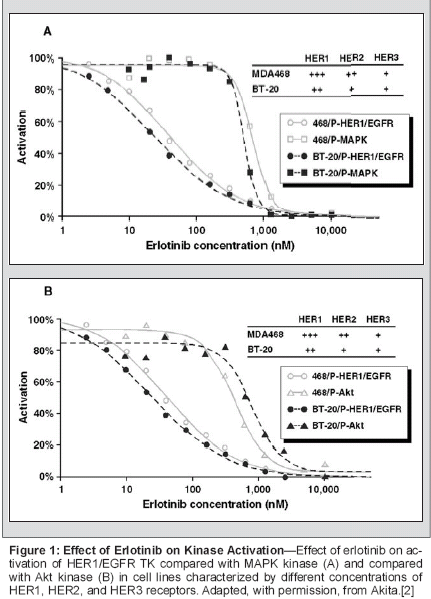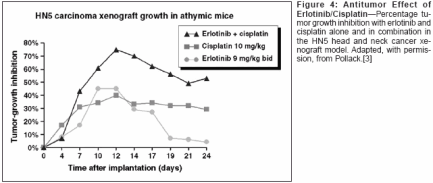Erlotinib: Preclinical Investigations
Erlotinib (Tarceva) is an orally available selective small-moleculeinhibitor of HER1/EGFR tyrosine kinase with a 50% inhibitory concentrationof 2 nM for purified tyrosine kinase. This agent has beenshown to produce stasis or regression of tumor growth in human cancerxenograft models, including non-small-cell lung cancer models.Ongoing preclinical investigations indicate that inhibition of the MAPKand Atk signaling pathways downstream of HER1/EGFR may be requiredfor optimal antitumor effects. Erlotinib exhibits inhibition ofMAPK and Atk kinases at concentrations higher than those requiredfor HER1/EGFR tyrosine kinase inhibition; such findings suggest thatmaximal inhibition of HER1/EGFR, requiring high erlotinib doses, isnecessary for optimum antitumor activity. These considerations aresupported by tumor models, including non-small-cell lung cancermodels, showing dose-related antitumor effects up to high doses oferlotinib. Erlotinib exhibits additive antitumor effects when combinedwith chemotherapeutic agents (cisplatin, doxorubicin, paclitaxel,gemcitabine [Gemzar], and capecitabine [Xeloda]), radiation therapy,and other targeted agents (eg, bevacizumab [Avastin]). Recent studiesindicate that erlotinib inhibits the EGFRvIII mutant at concentrationshigher than those required for inhibition of wild-type receptor. Ongoinginvestigation will help to determine optimal dosing and dose frequencyof erlotinib in various cancers in the clinical setting.
ABSTRACT: Erlotinib (Tarceva) is an orally available selective small-moleculeinhibitor of HER1/EGFR tyrosine kinase with a 50% inhibitory concentrationof 2 nM for purified tyrosine kinase. This agent has beenshown to produce stasis or regression of tumor growth in human cancerxenograft models, including nonâsmall-cell lung cancer models.Ongoing preclinical investigations indicate that inhibition of the MAPKand Atk signaling pathways downstream of HER1/EGFR may be requiredfor optimal antitumor effects. Erlotinib exhibits inhibition ofMAPK and Atk kinases at concentrations higher than those requiredfor HER1/EGFR tyrosine kinase inhibition; such findings suggest thatmaximal inhibition of HER1/EGFR, requiring high erlotinib doses, isnecessary for optimum antitumor activity. These considerations aresupported by tumor models, including nonâsmall-cell lung cancermodels, showing dose-related antitumor effects up to high doses oferlotinib. Erlotinib exhibits additive antitumor effects when combinedwith chemotherapeutic agents (cisplatin, doxorubicin, paclitaxel,gemcitabine [Gemzar], and capecitabine [Xeloda]), radiation therapy,and other targeted agents (eg, bevacizumab [Avastin]). Recent studiesindicate that erlotinib inhibits the EGFRvIII mutant at concentrationshigher than those required for inhibition of wild-type receptor. Ongoinginvestigation will help to determine optimal dosing and dose frequencyof erlotinib in various cancers in the clinical setting.
Several human malignancies, includingnon-small-cell lungcancer, are associated withdysregulation of the epidermal growthfactor receptor (HER1/EGFR). Thisdysregulation appears to play a pivotalrole in tumor growth and progression.Thus, HER1/EGFR and its associateddownstream signaling pathwaysare attractive targets for developmentof novel anticancer therapies. Erlotinib(Tarceva) is an orally available, potentHER1/EGFR tyrosine kinase inhibitorthat shows activity against a rangeof solid tumors, including non-smallcelllung cancer. This article reviewspreclinical data providing the rationalefor the clinical development oferlotinib in non-small-cell lung cancer,as well as ongoing preclinical investigationsand the additional insightsthey provide into the mechanisms underlyingantitumor effects of HER1/EGFR tyrosine kinase inhibition.Erlotinib CharacteristicsErlotinib is an orally availablequinazoline small-molecule inhibitorof HER1/EGFR tyrosine kinase. Themolecule is highly selective for HER/EGFR tyrosine kinase; studies with purified kinase show that the erlotinib50% inhibitory concentration (IC-50)for HER1/EGFR TK is 2 nM, comparedwith IC-50 values of 350 to> 10,000 nM for other receptorassociatedor cytoplasmic tyrosinekinases.[1] The erlotinib IC-50 incell-based assays is 20 nM. The HER1/EGFR is associated with twoimportant downstream signaling pathways,the MAPK pathway and the Aktpathway. Both of these pathways directlyinduce various cellular functions;in addition, the Akt pathwayactivates the PI3K pathway, which alsoinduces cellular functions. For inhibition of HER1/EGFR tyrosine kinaseto produce an antitumor effect, it appearsthat inhibition of one or both ofthese downstream pathways is necessary.

Recent studies in vitro show thaterlotinib inhibits MAPK phosphorylation,but does so at concentrationshigher than those required for inhibitionof HER1/EGFR TK phosphorylation(Figure 1)[2]; further, the concentrationrequired for inhibition isrelated to cytoplasmic concentrationsof HER1/EGFR found in different tumorcell lines. Similar findings were made for inhibition of Akt phosphorylation(Figure 1). These data suggestthat inhibition of downstream signalingpathways is likely to require inhibitionof the majority or nearly all ofthe HER1/EGFR receptors in the cellmembrane and that this effect is likelyto require exposure to high concentrationsof erlotinib.Erlotinib Effects inTumor ModelsThe relationship between highererlotinib concentrations and antitumor effect is more readily apparent in somehuman tumor models than in others.For example, assessment of the effectof various oral doses of erlotinib ontumor growth in the HN5 head andneck tumor xenograft model indicateda marked improvement in antitumoreffect between doses of 1.6 and 12.5mg/kg; since the 12.5 mg/kg dose resultedin no substantive tumor growth,relative improvements in antitumoreffect at higher doses are not readilyapparent (Figure 2).[3] However,evaluation of oral erlotinib in the A549non-small-cell lung cancer xenograftmodel shows clear improvement ofantitumor effect with an increase indose from 25 to 100 mg/kg (Figure2).[4] Experience with other tumormodels indicates that optimal antitumoreffect can be achieved only atsuch dose levels in many.Additional studies in tumor modelshave confirmed that the degree ofantitumor effect of erlotinib is relatedto the degree of inhibition of the receptortarget; for example, measurementsin vivo in HN5 head and neckcancer xenografts showed that percentagetumor growth inhibition duringerlotinib multiple-dose treatmentwas correlated with percentageHER1/EGFR phosphotyrosine inhibitionmeasured at 1 hour after individualdoses.[3] Further confirmationthat the antitumor effect is associatedwith degree of inhibition comes fromstudies in HN5 xenografts showing adose-related increase in induced tumorcell apoptosis (Figure 3); this effectis abolished with exposure to insulin-like growth factor-1, indicatingthat the apoptotic effect is indeed dependenton growth factor inhibition.These findings again point out thatmore complete receptor inhibition isnecessary to optimal antitumor effectand indicate the need for higherlotinib doses to achieve maximalinhibition.Effects of Erlotinibin CombinationThe rationale for using erlotinib orother HER1/EGFR inhibitors in combinationwith chemotherapeuticagents, radiation therapy, and/or othertargeted agents is that combining mo-dalities that have different mechanismsof action or that affect differentpathways may augment antitumorefficacy, as well as prevent developmentof tumor resistance. Preclinicalstudies of such combinations witherlotinib are ongoing. Initial findingswith combinations of erlotinib withchemotherapeutic agents in xenograftmodels showed significant tumorgrowth inhibition and no increase intoxicity when erlotinib was combinedwith cisplatin, doxorubicin,paclitaxel, gemcitabine (Gemzar), andcapecitabine (Xeloda)[3,5,6]; no interactionwas observed when erlotinibwas combined with fluorouracil andvinorelbine (Navelbine) tartrate inthe head and neck cancer model.Figure 4 shows the additive effect ontumor growth with the combinationof erlotinib and cisplatin in the HN5head and neck cancer xenograftmodel.[3]Recent evaluation of the combinationof erlotinib and radiation therapyshows that erlotinib increases the radiosensitivityof non-small-cell lungcancer cells and produces a significantdecrease in proportion of survivingcells per dose of radiation (Figure5).[7] Investigation of the combinationof erlotinib with other novel targetedagents has included studieswith the angiogenesis inhibitorbevacizumab (Avastin), an agent thathas demonstrated clinical activity inhuman colon cancer. Augmented activityof the erlotinib/bevacizumabcombination was found in human coloncancer xenografts (Figure 6), andhas been confirmed in the clinical setting.Augmented activity of the combinationis also observed in other tumormodels.

Erlotinib Activity AgainstHER1/EGFRvIII MutantThe EGFRvIII mutant is a truncatedHER1/EGFR variant (in-framedeletions of exons 2-7) with constitutively active tyrosine kinase that ispresent in a high percentage of primaryglial tumors and also is found in non-small-cell lung cancer, breast, and ovariantumors. Studies in vitro witherlotinib indicate that EGFRvIII levelswere minimally affected by 2-hourdrug exposure but markedly reducedover 24-hour exposure, with phosphorylationof the receptor being reducedat both 2 and 24 hours.[8] Such findingssuggest that for tumors with theEGFRvIII variant, and possibly othertumor types, prolonged drug exposureas well as high drug concentrationsmay be necessary for optimal antitumoreffect. Studies in tumor celllines that overexpress the wild-typeHER1/EGFR or the EGFRvIII variantshow that effects of erlotinib in inhibitingEGFRvIII receptor phosphorylationand cell proliferation are dose dependent,but with inhibition requiringhigher erlotinib concentrations comparedwith the wild-type receptor (Figure7). Clonogenic assays withEGFRvIII-overexpressing cell linesalso showed a dose-dependent effectof erlotinib inhibition, with markedinhibition of colony formation occurringat concentrations above 1 μM.




ConclusionErlotinib is an orally available,ATP-competitive, selective and reversibleinhibitor of HER1/EGFR TK. Inhuman cancer xenografts, it producesstasis or regression of tumor growth.Although the 50% effective dose is inthe 10-mg/kg range for some of thesemodels, accumulating data indicate that higher drug concentrations arenecessary in others to achieve optimumreceptor inhibition. This findingis in accordance with data indicatingthat higher doses and consequentmaximal receptor inhibition are necessaryfor adequate inhibition ofdownstream signaling pathways.Erlotinib exhibits additive antitumoreffects in combination with chemotherapeuticagents, radiation therapy,and other targeted agents. Erlotinib isalso active against EGFRvIII-transformedtumor cells, with inhibitionrequiring higher levels of drug exposurecompared with cells expressingthe wild-type receptor.
Disclosures:
The author(s) have no significant financial interest or other relationship with the manufacturers of any products or providers of any service mentioned in this article.
References:
1.
Moyer J, Barbacci EG, Iwata KK, et al:Induction of apoptosis and cell cycle arrest byCP-358,774, an inhibitor of epidermal growthfactor receptor tyrosine kinase. Cancer Res 57:4838-4848, 1997.
2.
Akita R, et al: abstract 4973. Proc AmAssoc Cancer Res 43:1003, 2002.
3.
Pollack VA, Savage DM, Baker DA, et al:Inhibition of epidermal growth factor receptorassociatedtyrosine phosphorylation in humancarcinomas with CP-358,774: Dynamics of receptorinhibition in situ and antitumor effectsin athymic mice. J Pharmacol Exp Ther291:739-748, 1999.
4.
Desai B, et al: abstract 203. Eur J Cancer38(suppl 7):63, 2002.
5.
Higgins B, Kolinsky K, Rashed M, et al:Differential antitumor activity of erlotinib (OSI-774) in combination with gemcitabine orcisplatin in a slow vs. fast growing xenograftmodel of human non-small cell lung cancer(abstract 907). Proc Am Soc Clin Oncol 22:226,2003.
6.
Tanaka Y, et al: abstract 4678. Proc AmAssoc Cancer Res 2003.
7.
Chinnaiyan P, et al: abstract R3790. ProcAm Assoc Cancer Res 2003.
8.
Iwata KK, Provoncha K, Gibson N: Inhibitionof mutant EGFRvIII transformed cellsby tyrosine kinase inhibitor OSI-774 (Tarceva)(abstract 79). Proc Am Soc Clin Oncol 21:21a,2002.
Newsletter
Stay up to date on recent advances in the multidisciplinary approach to cancer.